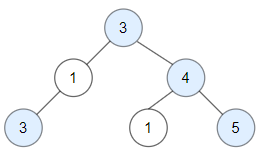Leetcode 1448. Count Good Nodes in Binary Tree
Explanation for Leetcode 1448 - Count Good Nodes in Binary Tree, and its solution in Python.
Problem
Leetcode 1448 - Count Good Nodes in Binary Tree
1
2
3
4
5
6
7
Input: root = [3,1,4,3,null,1,5]
Output: 4
Explanation: Nodes in blue are good.
Root Node (3) is always a good node.
Node 4 -> (3,4) is the maximum value in the path starting from the root.
Node 5 -> (3,4,5) is the maximum value in the path
Node 3 -> (3,1,3) is the maximum value in the path.
1
2
3
Input: root = [3,3,null,4,2]
Output: 3
Explanation: Node 2 -> (3, 3, 2) is not good, because "3" is higher than it.
1
2
3
Input: root = [1]
Output: 1
Explanation: Root is considered as good.
Approach
Since we’re only counting the nodes to be “good” if the node in the path from root to X there are no nodes with a value greater than X, we can use DFS to solve this problem.
Using DFS, we can keep track of the max_value of the nodes along the path, and if our child value is more than equal to max_value, then it’s a good node, else it’s a bad node.
Here is the Python code for the solution:
1
2
3
4
5
6
7
8
9
10
11
12
13
14
class Solution:
def goodNodes(self, root: TreeNode) -> int:
def dfs(root, max_val):
if not root:
return 0
res = 1 if root.val >= max_val else 0
max_val = max(max_val, root.val)
res += dfs(root.left, max_val)
res += dfs(root.right, max_val)
return res
return dfs(root, root.val)
Time Complexity and Space Complexity
Time Complexity: $O(n)$
Space Complexity: $O(n)$
This post is licensed under CC BY 4.0 by the author.

